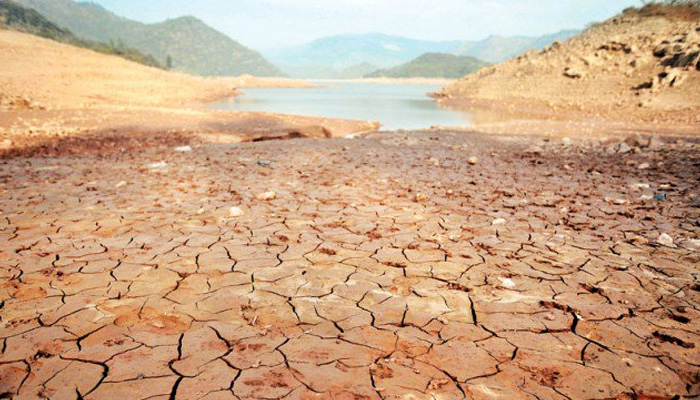Pakistan is on the brink of a severe water crisis, with the Indus River System Authority (IRSA) announcing that only drinking water will be supplied in April, while agricultural allocations will be suspended until May. The nation is grappling with a growing water scarcity exacerbated by climate change, poor water management practices, and rapidly increasing population pressure. The Meteorological Department has issued dire warnings of critical water shortages, particularly in the provinces of Sindh, Balochistan, and Punjab, which have been hit hard by an extended dry spell with rainfall levels far below average over the past six months.
The situation is further compounded by the dwindling water levels in the country’s two largest dams, Tarbela and Mangla, which have reached their “dead levels”—a grim indicator of water scarcity. With the Indus River facing erratic flows due to lower-than-normal snowfall in winter and unpredictable rainfall patterns, the country is entering the Kharif season (summer cropping) with an acute shortage of water. Experts warn that this scarcity is likely to worsen, posing a serious threat to agriculture, drinking water supplies, and overall economic stability.
The Scale of the Crisis
The water crisis has particularly affected Pakistan’s agricultural sector, with the country’s major breadbaskets—Punjab and Sindh—expected to face up to a 35% water shortage for the remaining Rabi crop season, including the vital wheat harvest. The impending scarcity will impact the Kharif crops as well, further straining food security. As agriculture consumes approximately 92% of the country’s water, these shortages threaten the livelihood of millions, particularly smallholder farmers who rely on a stable water supply for their crops.
Despite the hope that monsoon rains might alleviate some of the water shortages later in the year, experts caution that the crisis has become a recurring issue. Each year, Pakistan faces increasing droughts and water disputes between provinces, particularly between Sindh and Punjab, over water-sharing formulas. Meanwhile, urban centers like Islamabad, Karachi, Lahore, and Rawalpindi are already experiencing severe water shortages, exacerbating the strain on both rural and urban populations.
The Environmental and Governance Challenges
Pakistan’s water crisis is not solely a result of environmental factors, though climate change plays a significant role. Climate shifts have led to erratic rainfall patterns and accelerated glacial melt in the northern regions, further reducing the country’s freshwater supply. The Indus River, which serves as the primary water source, is under immense pressure from these disruptions, with its flow becoming increasingly unpredictable. The reduced snowfall in winter and decreased rainfall from September to March—40% below average—have compounded the issue, leaving reservoirs at critically low levels.
However, the underlying problem is Pakistan’s outdated water management system. The country’s irrigation infrastructure, largely developed during British colonial rule, has become inadequate to meet the demands of modern water usage, especially in the face of a changing climate. Experts argue that Pakistan’s water management is inefficient, with poor governance, outdated irrigation techniques, and widespread groundwater depletion worsening the crisis. Furthermore, the over-extraction of groundwater in urban areas like Karachi and Lahore, combined with a lack of proper replenishment strategies, is hastening the depletion of underground reserves.
The Role of Climate Change and Population Growth
Pakistan, though contributing less than 1% of global greenhouse gas emissions, is among the top ten countries most vulnerable to climate change. Rising global temperatures have altered rainfall patterns and accelerated glacial melt, leading to prolonged droughts and unpredictable monsoon seasons. As a result, Pakistan’s water availability per capita has fallen dramatically—from more than 5,000 cubic meters per person in 1947 to less than 1,000 cubic meters today, marking the country as water-scarce.
The implications of climate change for Pakistan are profound. By 2047, the country’s population is expected to double, while its water resources are likely to halve. This could lead to a 75% reduction in per capita water availability, exacerbating existing water scarcity issues. The agriculture sector, which already faces declining productivity, is expected to suffer even more due to reduced water supply, erratic rainfall, and higher temperatures.
Mismanagement and Inefficiency
Pakistan’s water crisis is largely a product of mismanagement. The country continues to lose vast amounts of water due to inefficient farming practices and outdated irrigation systems. Experts argue that the irrigation system, which was designed over 150 years ago, is no longer equipped to handle the stresses of the modern world. Instead of expanding irrigation into new lands, Pakistan needs to focus on improving efficiency on existing farmlands, particularly by reconsidering the cultivation of water-intensive crops like rice and sugarcane.
Former federal climate change minister Sherry Rehman highlighted the country’s poor governance, stating that the crisis is as much about inadequate policy enforcement and lack of investment in modern irrigation technology as it is about the climate crisis. Furthermore, unchecked groundwater depletion, particularly in rural areas, is putting additional pressure on the country’s already strained water resources.
The Need for a Paradigm Shift in Water Management
Experts stress that Pakistan needs a fundamental shift in how it manages water. Rather than investing billions in large-scale dam projects, which may not be sustainable in the face of unpredictable weather patterns and climate change, the country should prioritize modernizing existing infrastructure, repairing canals, and incentivizing water conservation practices at all levels.
Pakistan’s agriculture sector must also adopt more sustainable practices. Precision farming, drip irrigation, and the use of drought-resistant crops are key solutions for improving efficiency while reducing water consumption. Additionally, incentives for farmers to grow more water-efficient crops, such as legumes, could help alleviate pressure on water resources.
The Road Ahead
The water crisis in Pakistan is a structural challenge that requires immediate attention. Policymakers must implement both short-term solutions, such as improving water use efficiency and modernizing irrigation systems, and long-term strategies to address population growth, climate change, and water mismanagement.
In the near future, it is critical to invest in rainwater harvesting, groundwater recharge, and efficient irrigation technologies, alongside implementing public awareness campaigns that promote water conservation. Moreover, Pakistan must address the inefficiencies in its water distribution system to ensure equitable access to this precious resource.
Pakistan’s survival depends on its ability to secure its most vital resource—water. The country’s leaders must act swiftly and decisively to address this crisis, or risk facing even greater economic instability, food insecurity, and displacement in the years to come. Climate change will only exacerbate the problem, making it more urgent than ever to take action before the crisis spirals beyond control.










